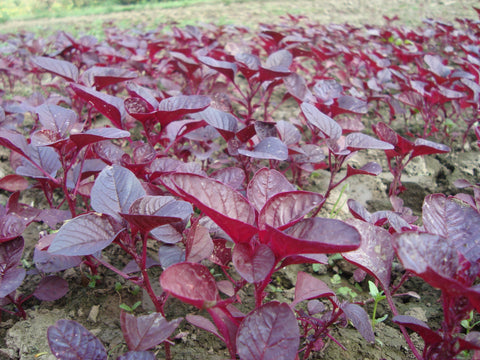10 Benefits of Red Spinach
Distinct from its green relative, red spinach is rapidly becoming the most popular nitric oxide superfood. Originally hailing from South America, this brilliantly red-hued leafy plant is now cultivated globally and boasts a plethora of health-enhancing nutrients. Here are ten benefits of red spinach, spotlighting its potential for overall health and longevity.
Red Spinach’s Robust Nutritional Profile
Red spinach differentiates itself from other leafy greens with its unique, nutrient-packed composition. Technically, red spinach is not like green spinach. It is the leaf of the amaranth plant. Its deep crimson red looks the part as a vital contributor to supporting a healthy heart. The feature that truly sets red spinach apart is its high concentration of nitrates. These naturally occurring compounds have been a point of interest within scientific circles since 1998, when the Nobel Prize was awarded to three scientists for their discovery of nitric oxide’s benefits for the cardiovascular system.
The Integral Role of Nitric Oxide in the Body
Nitric oxide is a vital component within our bodies, responsible for an array of physiological processes. It is instrumental in managing blood pressure, fortifying the immune system, and facilitating neural communication. Additionally, nitric oxide is involved in augmenting physical stamina and mitigating fatigue during physical exertion.
But where does nitric oxide come from? Our bodies can produce it using a non-essential amino acid known as L-arginine. Nitric oxide levels can be elevated by consuming dietary nitrates from food, which our bodies convert into nitric oxide.
This is where the nitrate-rich red spinach comes into the picture. By making red spinach and other nitrate rich foods a regular part of our lives, we can naturally stimulate nitric oxide production and tap into its health benefits.
Top 10 Benefits of Red Spinach
#1. Boosting Physical Performance
Let's look into how the high nitrate content in red spinach contributes to reduced fatigue and increased stamina, enabling you to enjoy activities like leisurely strolls or invigorating runs. As red spinach is celebrated for its role in increasing nitric oxide production and promoting robust circulation, it naturally follows that it also elevates physical performance.
Numerous research studies indicate that adding red spinach to your diet increases nitric oxide levels, leading to enhanced endurance during physical activities. A 2021 study highlighted that foods rich in polyphenols and nitrates, like red spinach, offer considerable benefits for endurance exercise performance. The study demonstrated that these nutrients work synergistically to boost athletic stamina and enhance the body's overall endurance.
#2. Promoting Heart Health
A compelling analysis in 2017 shed light on a significant connection: consistent intake of phytosterols - around 2 grams per day - was associated with supporting cardiovascular health. Red spinach is naturally rich in phytosterols. These plant-based compounds have earned accolades for their positive effects on cardiovascular health. The research highlights the importance of red spinach in supporting a healthy heart.
#3. Supporting Eye Health
Lutein and Zeaxanthin are two key nutrients present in red spinach that are commonly known for promoting eye health. Red spinach can be instrumental in maintaining good vision and helping to support overall eye health. It is also rich in other essential nutrients that may support the optic nerves and healthy vision.
#4. Mitigating Erectile Dysfunction
Given that nitric oxide supplements have been known to improve blood flow, scientists have sought to understand their potential impact on conditions like erectile dysfunction (ED). An article in the journal Future Science OA, based on several studies, suggests that nitric oxide supplementation might alleviate ED symptoms, particularly for those experiencing mild to moderate cases.
As a natural and rich source of nitrates, which the body can convert into nitric oxide, consuming red spinach may support healthy blood flow. While more research is needed in this area, the current findings suggest that incorporating nitrate-rich foods like red spinach into one's diet could be a good plant-based option for supporting ED.
#5. Revitalizes Skin Health
The remarkable concentration of vitamins A, C, and E, coupled with essential minerals in red spinach, make it a potential ally for skin health. These antioxidants may help combat free radicals that damage skin, thereby promoting a radiant complexion and potentially delaying signs of aging.
Research in the Journal of Skin Pharmacology and Physiology back in 2012 highlighted the positive impact of dietary antioxidants on skin health and the aging process. Red spinach is a powerhouse of these antioxidants, and may contribute to vibrant, healthier skin. While additional research is necessary to confirm the specific effects of red spinach on skin health, incorporating this nutrient-rich vegetable into your diet is a plant-based option to help support skin health.
#6. Natural Antimicrobial Effects
Betacyanins, reddish to violet pigments, are found in several plants, including red pitahaya (Hylocereus polyrhizus) and red spinach (Amaranthus dubius). A 2017 study compared these two plants, while also analyzing their betacyanin content and antimicrobial activities.
Both plants were found to contain betanin, with additional unique compounds like amaranthine and decarboxy-amaranthine in red spinach. Most notably, the betacyanin fraction from red spinach showed superior antimicrobial activity compared to red pitahaya against nine strains of Gram-positive bacteria and five strains of Gram-negative bacteria.
This result might be attributed to the higher amount of betacyanin, specifically amaranthine, present in red spinach. These findings highlight the potential of red spinach as a natural antimicrobial agent, further reinforcing its standing as a health-promoting superfood.
#7. Reducing Muscle Fatigue and Enhancing Recovery
Nitric oxide, which can be boosted by consuming high-nitrate foods like red spinach, supports healthy blood flow to muscles during workouts. This leads to improved delivery of oxygen and nutrients to the muscles, enhancing endurance, power, and overall performance.
Moreover, nitric oxide has been identified as a potent agent for aiding muscle recovery after strenuous exercise. A 2016 study specifically highlighted the role of dietary nitrates, such as those found in red spinach and beetroot, in this process. The study found that nitrate supplementation led to improved muscle recovery following intense exercise. It also significantly reduced muscle soreness by mitigating inflammation markers.
#8. Support Healthy Blood Pressure
A 2012 study specifically explored the impact of red spinach on supporting healthy blood pressure levels. The research indicated that red spinach helped increase nitric oxide status in the body. Nitric oxide plays a crucial role in healthy blood vessels. The study further highlighted the ability of red spinach to support the health of the inner lining of our blood vessels.
Incorporating red spinach into one's diet could be a natural and effective strategy for managing healthy blood pressure levels and promoting overall cardiovascular wellness.
#9. Digestive Health Support
Red spinach contains dietary fiber which is essential for a healthy digestive system. Dietary fiber adds bulk to the stool, facilitates regular bowel movements, and thus can help prevent constipation. A 2012 study published in the Journal of Agricultural and Food Chemistry showed that dietary fiber content in red spinach is higher than in other spinach varieties, making it a potentially beneficial addition to the diet for those seeking to improve their digestive health.
#10. Supports Bone Health
Red spinach is rich in Vitamin K, a nutrient essential for bone health. Vitamin K plays a critical role in bone metabolism and helps regulate bone mineralization. A review published in the journal Nutrients in 2017 suggested that adequate intake of vitamin K may help support healthy bones.
The Remarkable Health Rewards of Red Spinach
Red spinach proves itself to be more than just a colorful addition to our diet. This nutrient-rich superfood offers a broad array of scientifically backed benefits, ranging from improved physical performance to supporting healthy aging.
The key nutrient in spinach is its natural high nitrate content, which increases nitric oxide levels in our bodies. While more research will likely uncover red spinach’s diverse benefits, current findings show many benefits for this functional food.
Resources:
d'Unienville NMA, Blake HT, Coates AM, Hill AM, Nelson MJ, Buckley JD. Effect of food sources of nitrate, polyphenols, L-arginine and L-citrulline on endurance exercise performance: a systematic review and meta-analysis of randomized controlled trials. J Int Soc Sports Nutr. 2021 Dec 29;18(1):76. doi: 10.1186/s12970-021-00472-y. PMID: 34965876; PMCID: PMC8715640.
Cabral CE, Klein MRST. Phytosterols in the Treatment of Hypercholesterolemia and Prevention of Cardiovascular Diseases. Arq Bras Cardiol. 2017 Nov;109(5):475-482. doi: 10.5935/abc.20170158. PMID: 29267628; PMCID: PMC5729784.
Davies KP. Development and therapeutic applications of nitric oxide releasing materials to treat erectile dysfunction. Future Sci OA. 2015 Aug;1(1):FSO53. doi: 10.4155/fso.15.53. PMID: 27019746; PMCID: PMC4806684.
Sani HA, Rahmat A, Ismail M, Rosli R, Endrini S. Potential anticancer effect of red spinach (Amaranthus gangeticus) extract. Asia Pac J Clin Nutr. 2004;13(4):396-400. PMID: 15563447.
Yong YY, Dykes G, Lee SM, Choo WS. Comparative Study of Betacyanin Profile and Antimicrobial Activity of Red Pitahaya (Hylocereus polyrhizus) and Red Spinach (Amaranthus dubius). Plant Foods Hum Nutr. 2017 Mar;72(1):41-47. doi: 10.1007/s11130-016-0586-x. PMID: 27917454.
Clifford T, Bell O, West DJ, Howatson G, Stevenson EJ. The effects of beetroot juice supplementation on indices of muscle damage following eccentric exercise. Eur J Appl Physiol. 2016 Feb;116(2):353-62. doi: 10.1007/s00421-015-3290-x. Epub 2015 Nov 4. PMID: 26537365.
Bondonno CP, Yang X, Croft KD, Considine MJ, Ward NC, Rich L, Puddey IB, Swinny E, Mubarak A, Hodgson JM. Flavonoid-rich apples and nitrate-rich spinach augment nitric oxide status and improve endothelial function in healthy men and women: a randomized controlled trial. Free Radic Biol Med. 2012 Jan 1;52(1):95-102. doi: 10.1016/j.freeradbiomed.2011.09.028. Epub 2011 Oct 1. PMID: 22019438.
Tsugawa N, Shiraki M. Vitamin K Nutrition and Bone Health. Nutrients. 2020 June 27;12(7):1909. doi: 10.3390/nu12071909. PMID: 32605143; PMCID: PMC7399911.





Comments (0)
There are no comments for this article. Be the first one to leave a message!